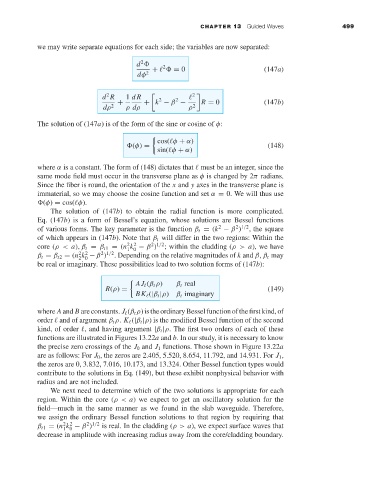Page 517 - Engineering Electromagnetics, 8th Edition
P. 517
CHAPTER 13 Guided Waves 499
we may write separate equations for each side; the variables are now separated:
2
d + = 0 (147a)
2
dφ 2
2
d R 1 dR 2
2
2
+ + k − β − R = 0 (147b)
dρ 2 ρ dρ ρ 2
The solution of (147a)isof the form of the sine or cosine of φ:
cos( φ + α)
$
(φ) = (148)
sin( φ + α)
where α is a constant. The form of (148) dictates that must be an integer, since the
same mode field must occur in the transverse plane as φ is changed by 2π radians.
Since the fiber is round, the orientation of the x and y axes in the transverse plane is
immaterial, so we may choose the cosine function and set α = 0. We will thus use
(φ) = cos( φ).
The solution of (147b)to obtain the radial function is more complicated.
Eq. (147b)isa form of Bessel’s equation, whose solutions are Bessel functions
2
2 1/2
of various forms. The key parameter is the function β t = (k − β ) , the square
of which appears in (147b). Note that β t will differ in the two regions: Within the
2 2
2 1/2
core (ρ< a),β t = β t1 = (n k − β ) ; within the cladding (ρ> a), we have
1 0
2 1/2
2 2
β t = β t2 = (n k − β ) . Depending on the relative magnitudes of k and β, β t may
2 0
be real or imaginary. These possibilities lead to two solution forms of (147b):
AJ (β t ρ) β t real
$
R(ρ) = (149)
BK (|β t |ρ) β t imaginary
where A and B areconstants. J (β t ρ)istheordinaryBesselfunctionofthefirstkind,of
order and of argument β t ρ. K (|β t |ρ)is the modified Bessel function of the second
kind, of order , and having argument |β t |ρ. The first two orders of each of these
functions are illustrated in Figures 13.22a and b.In our study, it is necessary to know
the precise zero crossings of the J 0 and J 1 functions. Those shown in Figure 13.22a
are as follows: For J 0 , the zeros are 2.405, 5.520, 8.654, 11.792, and 14.931. For J 1 ,
the zeros are 0, 3.832, 7.016, 10.173, and 13.324. Other Bessel function types would
contribute to the solutions in Eq. (149), but these exhibit nonphysical behavior with
radius and are not included.
We next need to determine which of the two solutions is appropriate for each
region. Within the core (ρ< a)weexpect to get an oscillatory solution for the
field—much in the same manner as we found in the slab waveguide. Therefore,
we assign the ordinary Bessel function solutions to that region by requiring that
2 2
2 1/2
β t1 = (n k − β ) is real. In the cladding (ρ> a), we expect surface waves that
1 0
decrease in amplitude with increasing radius away from the core/cladding boundary.

